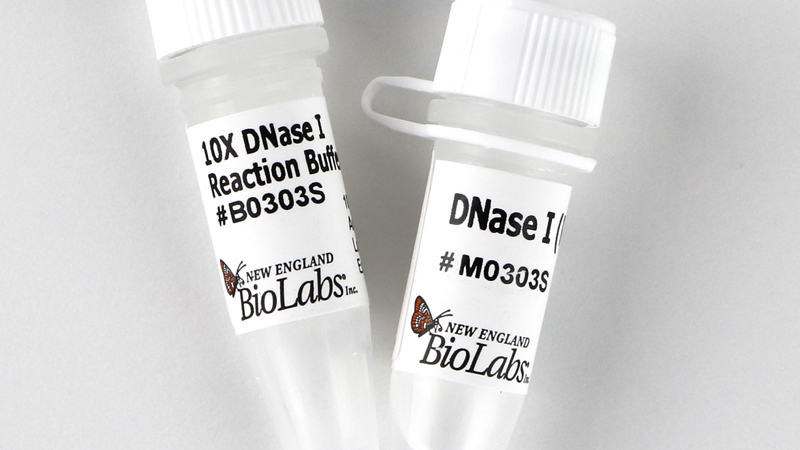Duplex DNase
Product information| Code | Name | Size | Quantity | Price | |
|---|---|---|---|---|---|
M7635S |
Duplex DNase |
150 units ( 2000 units/ml ) | - | Unavailable in your region | |
M7635L |
Duplex DNase |
750 units ( 2000 units/ml ) | - | Unavailable in your region |
Duplex DNase
Catalog #M7635
Product Introduction

- DNA-specific endonuclease
- Specifically degrades dsDNA in the presence of ssDNA
- Cleaves DNA strand of DNA:RNA hybrid duplex
- Products are short oligos or ssRNA (if cleaving the DNA strand of DNA:RNA hybrid)
Duplex DNase is ideal for:
- Removal of contaminating gDNA prior to RT-qPCR
- Removal of contaminating DNA from RNA or protein preps
- PCR decontamination
- Consider DNase I (RNase-free) or DNaseI-XT for IVT applications
- Product Information
- Protocols, Manuals & Usage
- Tools & Resources
- FAQs & Troubleshooting
- Citations & Technical Literature
- Quality, Safety & Legal
- Other Products You May Be Interested In
Product Information
Description
Duplex DNase is an engineered double-strand-specific DNA endonuclease that preferentially degrades double-stranded DNA (dsDNA) over single-stranded DNA (ssDNA) or RNA. It will also cleave the DNA strand of a DNA:RNA hybrid duplex.



Product Source
A His-tagged engineered Duplex DNase expressed in Pichia pastoris.- This product is related to the following categories:
- Exonucleases and Non-specific Endonucleases
- This product can be used in the following applications:
- cDNA Synthesis
Reagents Supplied
Reagents Supplied
The following reagents are supplied with this product:
| NEB # | Component Name | Component # | Stored at (°C) | Amount | Concentration | |||||||||||||||||||
|---|---|---|---|---|---|---|---|---|---|---|---|---|---|---|---|---|---|---|---|---|---|---|---|---|
| ||||||||||||||||||||||||
| ||||||||||||||||||||||||
Properties & Usage
Unit Definition
One unit is defined as the amount of enzyme required to release 3 pmol of FAM from a 35-mer FAM-BHQ1 labeled hairpin oligonucleotide in 1 minute at 30°C in a 50 µl reaction volume.Reaction Conditions
1X NEBuffer™ r2.1
1X NEBuffer™ r2.1
50 mM NaCl
10 mM Tris-HCl
10 mM MgCl2
100 µg/ml Recombinant Albumin
(pH 7.9 @ 25°C)
Usage Concentration
2,000 units/mlStorage Buffer
10 mM Tris-HCl
50 mM KCl
50% Glycerol
pH 7.4 @ 25°C
Heat Inactivation
75°C for 10 minutes in the presence of 1 mM DTT. If the sample contains RNA, we recommend adding EDTA (10 mM final concentration) and DTT (1 mM final concentration), prior to heat inactivation. RNA may degrade at temperatures > 65°C in the presence of divalent metals such as Mg2+.
Related Products
Companion Products
Protocols, Manuals & Usage
Protocols
Tools & Resources
Selection Charts
FAQs & Troubleshooting
FAQs
- Can Duplex DNase be heat-inactivated?
- Is Duplex DNase inhibited by salt?
- At what temperature should I use Duplex DNase?
- What is the minimal length of duplex DNA required for Duplex DNase to cleave?
- Does Duplex DNase require divalent cations?
- What are the optimal reaction conditions for Duplex DNase?
- How does the unit definition for Duplex DNase compare to other duplex-specific DNases?
Citations & Technical Literature
Citations
Quality, Safety & Legal
Quality Assurance Statement
Quality Control tests are performed on each new lot of NEB product to meet the specifications designated for it. Specifications and individual lot data from the tests that are performed for this particular product can be found and downloaded on the Product Specification Sheet, Certificate of Analysis, data card or product manual. Further information regarding NEB product quality can be found here.Specification Change Notifications
Specifications
The Specification sheet is a document that includes the storage temperature, shelf life and the specifications designated for the product. The following file naming structure is used to name these document files: [Product Number]_[Size]_[Version]Certificate Of Analysis
The Certificate of Analysis (COA) is a signed document that includes the storage temperature, expiration date and quality controls for an individual lot. The following file naming structure is used to name these document files: [Product Number]_[Size]_[Version]_[Lot Number]Safety DataSheets
The following is a list of Safety Data Sheet (SDS) that apply to this product to help you use it safely.Duplex DNase
NEBuffer™ r2.1
Legal and Disclaimers
Products and content are covered by one or more patents, trademarks and/or copyrights owned or controlled by New England Biolabs, Inc (NEB). The use of trademark symbols does not necessarily indicate that the name is trademarked in the country where it is being read; it indicates where the content was originally developed. The use of this product may require the buyer to obtain additional third-party intellectual property rights for certain applications. For more information, please email busdev@neb.com.This product is intended for research purposes only. This product is not intended to be used for therapeutic or diagnostic purposes in humans or animals.
New England Biolabs (NEB) is committed to practicing ethical science – we believe it is our job as researchers to ask the important questions that when answered will help preserve our quality of life and the world that we live in. However, this research should always be done in safe and ethical manner. Learn more.
Other Products You May Be Interested In
The supporting documents available for this product can be downloaded below.

